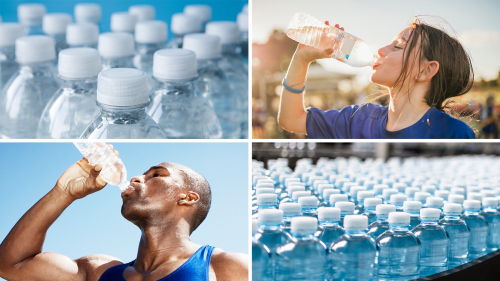U.S. Food & Drug Administration (FDA)

Seems like almost everyone is carrying a bottle of water these days.
The U.S. Food and Drug Administration regulates bottled water products, working to ensure that they’re safe to drink.
The FDA protects consumers of bottled water through the Federal Food, Drug, and Cosmetic Act (FD&C Act), which makes manufacturers responsible for producing safe, wholesome, and truthfully labeled food products.
There are regulations that focus specifically on bottled water, including:
- “standard of identity” regulations that define different types of bottled water
- “standard of quality” regulations that set maximum levels of contaminants—including chemical, physical, microbial, and radiological contaminants—allowed in bottled water
- “current good manufacturing practice” (CGMP) regulations that require bottled water to be safe and produced under sanitary conditions
Types of Bottled Water
The FDA describes bottled water as water that’s intended for human consumption and sealed in bottles or other containers with no added ingredients, except that it may contain safe and suitable antimicrobial agents. Fluoride may also be added within the limits set by the FDA.
The agency classifies some bottled water by its origin. Here are four of those classifications:
- Artesian well water. This water is collected from a well that taps an aquifer—layers of porous rock, sand, and earth that contain water—which is under pressure from surrounding upper layers of rock or clay. When tapped, the pressure in the aquifer, commonly called artesian pressure, pushes the water above the level of the aquifer, sometimes to the surface. Other means may be used to help bring the water to the surface.
- Mineral water. This water comes from an underground source and contains at least 250 parts per million total dissolved solids. Minerals and trace elements must come from the source of the underground water. They cannot be added later.
- Spring water. Derived from an underground formation from which water flows naturally to the surface, this water must be collected only at the spring or through a borehole that taps the underground formation feeding the spring. If some external force is used to collect the water through a borehole, the water must have the same composition and quality as the water that naturally flows to the surface.
- Well water. This is water from a hole bored or drilled into the ground, which taps into an aquifer.
Bottled water may be used as an ingredient in beverages, such as diluted juices or flavored bottled waters. However, beverages labeled as containing “sparkling water,” “seltzer water,” “soda water,” “tonic water,” or “club soda” aren’t included as bottled water under the FDA’s regulations. These beverages are instead considered to be soft drinks.
It May Be Tap Water
Some bottled water also comes from municipal sources—in other words, public drinking water or tap water. Municipal water is usually treated before it is bottled. Examples of water treatments include:
- Distillation. Water is turned into a vapor, leaving minerals behind. Vapors are then condensed into water again.
- Reverse osmosis. Water is forced through membranes to remove minerals.
- Absolute 1 micron filtration. Water flows through filters that remove particles larger than one micron—.00004 inches—in size. These particles include Cryptosporidium, a parasitic pathogen that can cause gastrointestinal illness.
- Ozonation. Bottlers of all types of waters typically use ozone gas, an antimicrobial agent, instead of chlorine to disinfect the water. (Chlorine can add residual taste and odor to the water.)
Bottled water that has been treated by distillation, reverse osmosis, or another suitable process may meet standards that allow it to be labeled as “purified water.”
Ensuring Quality and Safety
Federal quality standards for bottled water were first adopted in 1973. They were based on U.S. Public Health Service standards for drinking water set in 1962.
The 1974 Safe Drinking Water Act gave regulatory oversight of public drinking water to the U.S. Environmental Protection Agency (EPA). The FDA subsequently took responsibility, under the FD&C Act, for ensuring that the quality standards for bottled water are compatible with EPA standards for public drinking water.
Each time EPA establishes a standard for a contaminant, the FDA either adopts it for bottled water or finds that the standard isn’t necessary for bottled water.
In some cases, standards for bottled water and public drinking water differ. For example, because lead can leach from pipes as water travels from water utilities to home faucets, EPA has set its limit for lead in public drinking water water at 15 parts per billion (ppb). For bottled water, for which lead pipes aren’t used, the lead limit is set at 5 ppb.
For bottled water production, bottlers must follow the CGMP regulations that are specific to processing and bottling drinking water, put in place and enforced by the FDA. Water must be sampled, analyzed, and found to be safe and sanitary. These regulations also require proper plant and equipment design, bottling procedures, and record keeping.
In addition, bottled water processors are generally required to register with the FDA as food facilities. Domestic and foreign facilities that are required to register as food facilities must comply with the requirements for risk-based preventive controls mandated by the FDA Food Safety Modernization Act (FSMA) as well as the modernized Current Good Manufacturing Practices (CGMPs) of this rule that cover all human food facilities (unless an exemption applies). Please see FDA’s Preventive Controls for Human Food webpage for additional details.
Furthermore, the FDA oversees inspections of bottling plants. The agency inspects bottled water plants under its general food safety program and has states perform some plant inspections under contract. (Some states also require bottled water firms to be licensed annually.)